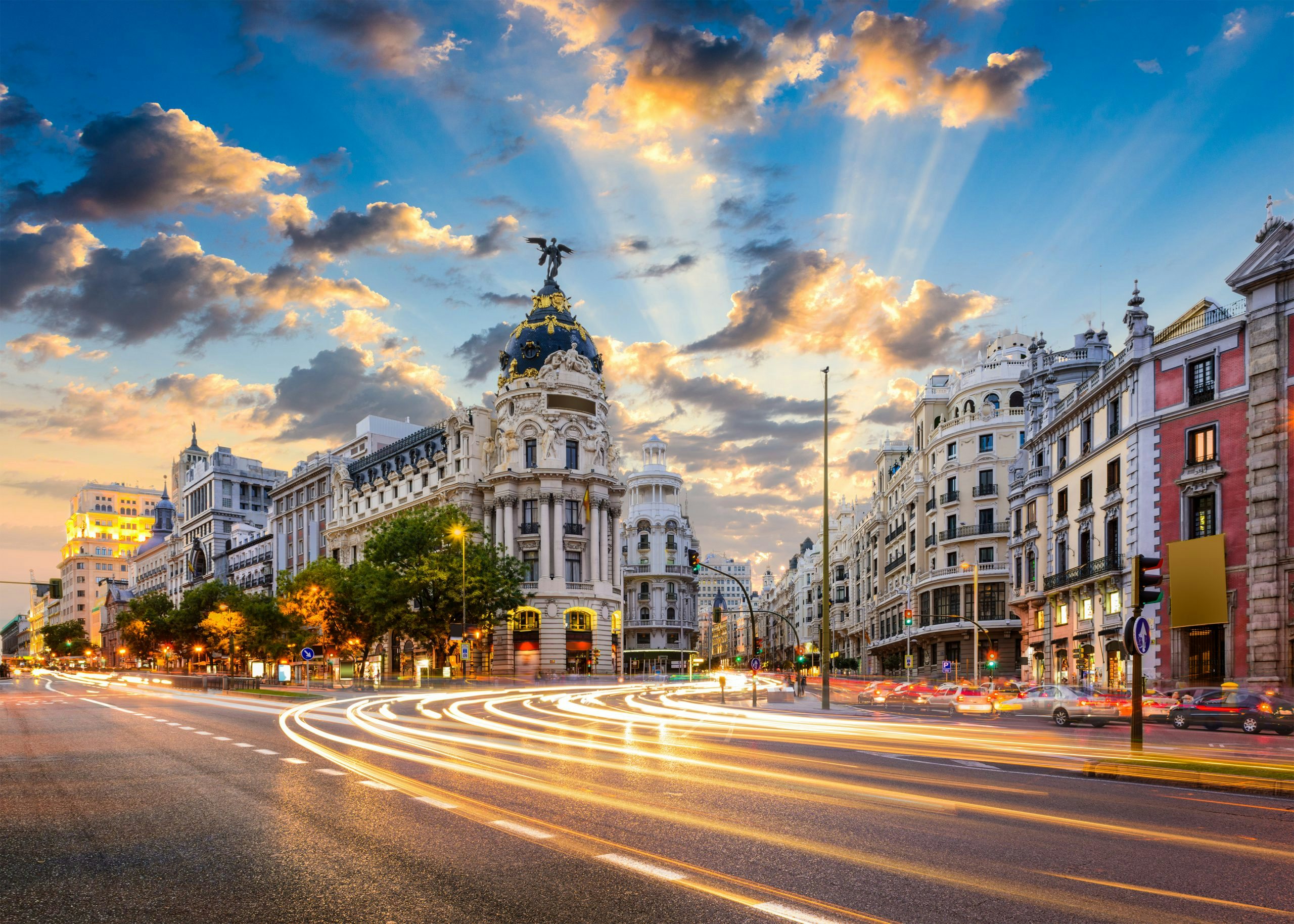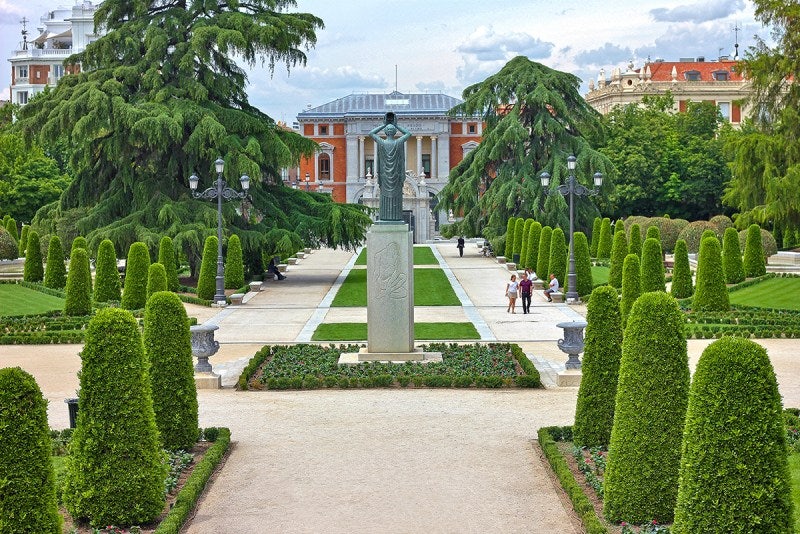Luxury Travel Guide for Spain's lively Capital of Madrid

Madrid, Spain’s lively capital, is a city of elegant boulevards and expansive manicured parks, a maze of beautiful streets. It’s renowned for its rich repositories of European art, including the Museo Reina Sofia and Prado Museum’s works by Goya, Velázquez and other Spanish masters, while the nearby El Retiro Park is home to several sculptures, monuments and a boating lake. When meandering through the park’s famed wide-open spaces and rose garden, it’s always an unexpected pleasure to take in some street theatre, or, if visiting in the summer, to stop to browse at the annual book fair.

Madrid’s architecture has preserved the look and feel of most historic neighborhoods and streets, despite the city possessing modern infrastructure. Landmarks include the Royal Palace of Madrid, the official residence of the Spanish Royal Family located in the beautiful and culturally vibrant Ópera district, the Royal Theatre with its restored 1850 Opera House, and the Plaza de Cibeles, a square with a neo-classical complex of marble sculptures and fountains, which has become an iconic symbol for the city center.
Much of the city is flat, making it is easy to cover on foot. For a more elevated experience, Madrid’s cable car — the Teleférico — won’t disappoint. The journey starts on the Paseo del Pintor Rosales street, near the Argüelles Metro station, and offers a stunning panoramic view over the River Manzanares and into the largest park in Madrid, Casa de Campo or “Country House,” so-called due to its one-time status as a royal hunting estate.

A short walk from Casa de Campo is the Gran Vía, an ornate and upscale shopping street located in central Madrid. Known today as the Spanish Broadway, it boasts the most nightlife in Europe and has earned the nickname “the street that never sleeps.” Here, the boulevards are adorned with lively tapas bars — the quintessential and ubiquitous Spanish food — as is the hip and trendy neighborhood or “barrio” of La Latina. One of the most genuinely authentic neighborhoods in Madrid, much frequented by locals, its medieval streets are arranged around the squares of La Cebada and La Paja, and are alive with numerous bars, pubs and traditional taverns.

The most exclusive neighborhood is Barrio de Salamanca, or “The Golden Mile,” famed for its rows of boutiques and luxury labels, including Gucci, Chanel, Dior and Prada. It also is now home to the recently opened restaurant Tatel — co-owned by Rafael Nadal, Enrique Iglesias and Pau Gasol — and Madrid’s highly anticipated new cocktail bar Beker 6. Offering light refreshment in between fashion sprees, the signature Beker 6 cocktail features dried hibiscus petals heated with Ysabel Regina, a French brandy aged in Pedro Ximénez sherry casks.
But while others shop, bagging a much-coveted seat at the Santiago Bernabeu Stadium to see Real Madrid — one of the best football teams in the world — play is often at the top of most people’s bucket lists. Keep energy levels up while watching from the sidelines with some “chocolate con churros,” a delightful snack of light, crispy sticks of fried dough. There are, of course, other ways of being immersed in Madrid’s long-standing cultural heritage; a night of traditional flamenco is unsurpassed. Madrid has been a stage for the world’s best flamenco since the early 19th century, and the Corral de la Morería is widely recognized as the premier flamenco restaurant in the city.
Alternatively, the less squeamish can take in a Spanish bullfight — an exhilarating experience, albeit somewhat controversial. The best months to see bullfights in Madrid are May and June when the world-famous San Isidro bullfight festival takes place bringing together the best fighters, bulls and aficionados. There are fights every day for 20 days, starting at 7 p.m., with novillos (young bulls), rejones (bullfights on horseback) and Goyesca fights (in period costume). Madrid’s main bullring, La Plaza de Toros de Las Ventas del Espíritu Santo, is an impressive building formed of red brick and ceramic tiles and built in mudéjar style.
Alongside incredible food markets, such as Mercado San Miguel, Madrid’s restaurants are dripping with awards and accolades. Enjoy experimental seaweed lollipops at two-Michelin starred La Terraza, where Spain’s most influential chef, Ferran Adrià, from the famed El Bulli, serves as gastronomic consultant or sample classic Spanish cuisine at Viridiana, which serves hearty, flavorful dishes such as gazpacho with Sardinian bread and filet of beef with chili sauce.
Once competing with a litany of two-Michelin starred restaurants in the capital, the unique menu at DiverXO has pushed to the very top of the gastronomic tree, earning itself Madrid’s first-ever three-Michelin stars. The unique menu fuses Iberian and Asian cuisine within highly unusual dishes served as works of culinary art. The décor featuring ominous swarms of black butterflies on the ceiling and large flying pigs on the tables make dining at DiverXO an unexpected experience. The Spanish tend to eat much later than their European counterparts, so it’s not unusual to sit down to dine past 10 p.m. Thus, the benefit of a well-situated hotel soon becomes apparent at the end of an exhausting day, and the ME Madrid Reina Victoria, widely known as the bullfighters’ hotel, is located next to the city’s main theaters, boutiques and nightclubs. More importantly, it is home to one of the coolest bars in town, The Roof, where you can gaze upon Madrid’s iconic skyline while sipping goblets of flamboyantly garnished “gin tonics” before flopping into bed.
For a quieter affair, the Santo Mauro hotel is housed in an elegant, late 19th-century building that was once the residence of the Duke of Santo Mauro, a highly influential member of Madrid’s society in his time. The Ritz is located right in the center of Madrid opposite the Prado and Thyssen museums and possesses splendid terraces and gardens for its guests.
A trip to Madrid would not be complete without a dip in one of its exclusive rooftop pools. A secret paradise hiding on top of some of the city’s hotels, the lounge vibe of La Terraza de Oscar Pool Club or the Emperador’s garden-pool area are a perfect way to escape the heady heat in summer. Alternatively, if you want to truly escape the city center for a few hours, head to one of Madrid’s piscinas naturales, such as Embalse de Picadas, a natural flowing lake surrounded by a beautiful pine forest. It’s the perfect place to wind down from a whirlwind weekend in one of Europe’s best capital cities.
Read Next
Navigator Newsletter Stay informed on all things yachting and luxury lifestyle with the bi-monthly Navigator newsletters.
